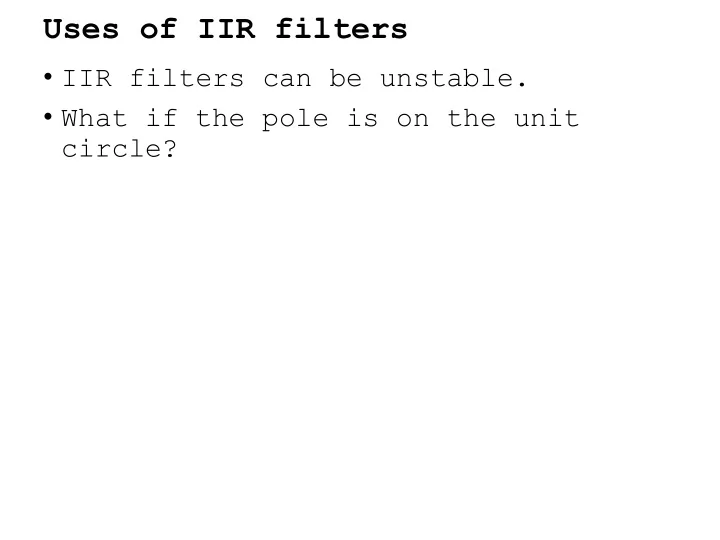

Uses of IIR filters • IIR filters can be unstable. • What if the pole is on the unit circle?
Interesting use of IIR filter • IIR filters can be unstable. • What if the pole is on the unit circle? • a = [1 a1 1] with (-2<a1<2) • What does the impulse response look like? Possible poles for bp=3.
BP=5, a=(1/32)*[32,-31,32] =[1,-0.96875,1]
Filtering 1320 kHz at 125 MHz • We need a very narrow band filter to recover the 10 kHz signal. • A direct filter requires too many taps. • Decimation: taking every N th sample allows reduction in the frequency range and # of taps. • By 2, signals in the range 31.25 to 62.5 are aliased into 31.26 to 0 MHz. When you decimate by 2 a frequency at 1/2 the sampling frequency appears as a constant (f=0).
Filtering 1320 kHz at 125 MHz • Use a filter to precondition the signal prior to decimation. • Filter the signal to reduce the energy that is aliased from the (31.25 to 62.5 band) into the (0 to 31.25 band) and on. • Half Band Filter: Design problem... When you decimate by 2 a frequency at 1/2 the sampling frequency appears as a constant (f=0).
Half Band FIR/IIR Filter • Design a Filter with 4 poles and 4 zeros with the following constraints. • Start with a constrained mathematical model. • Efficient half-band filter: • All poles are on the y-axis and have magnitude < 1. • All zeros are on the unit circle between pi/2 and – pi/2. • Final transfer function takes on the form: H(z) = (1 + b 01 z -1 + 1)(1 + b 11 z -1 + 1) (1 + a 02 z -2 )(1 + a 12 z -2 ) • b X1 are between 0 and 2 • a X2 are between 0 and 1
Coefficients • b 01 ,b 02 = 0.750,1.750 • a 02 ,a 12 = 0.125,0.5625
Block Diagrams z -1 z -1 z -1 z -1 b 01 b 11 z -1 z -1 z -1 z -1 a 02 a 12 + - + - subtraction subtraction
FIR Cascade z -1 z -1 z -1 z -1 x4 x4 3 7 <<<2 <<<2 bp is increased by 4. x4 x4 <<<2 <<<2 x4-1 x8-1 z -1 3 7 x4 x4 x4 x4 <<<2 <<<2 <<<2 <<<2 bp is increased by 4. z -1 z -1 z -1 z -1
IIR Cascade bp is increased by 7. z -2 9 z -2 x16 correct bp <<<4 >>>4 1 x8 correct bp <<<3 >>>3
FIR/IIR Cascade 1,1.75,1 = 3.75 = 3 bits BP is increased by 2. Total = 5 Total Width increase by 22. x4-1 x8-1 BP net is increased by 11. z -1 3 7 x4 x4 x4 x4 Sum(.5625^(0:inf)) = 3. <<<2 <<<2 <<<2 <<<2 BP is increased by 4. Total = 7. z -1 z -1 z -1 z -1 z -2 1,.75,1 = 2.75 = 3 bits. BP is increased by 2. Total = 5 9 x16 Total BP = 11. <<<4 Coefficients ... z -2 ceil(log2(sum(f1 × f2 × f3 × f4)))+1=6 correct bp >>>4 14 input 1 BP is 11 Coefficients are 6 Sum(.125^(0:inf)) = 2. =31 (we will use 32) BP is increased by 3. Total = 5. x8 correct bp <<<3 >>>3
Impulse Response
Comparison to Simulation
Decimate by 2 without LPF
Decimate by 2 with LPF
FIR/IIR Cascade bp net is increased by 11. z -1 z -1 x4-1 x8-1 3 7 x4 x4 x4 x4 <<<2 <<<2 <<<2 <<<2 bp is increased by 7. z -1 z -1 z -1 z -1 z -2 ↓2 9 x16 bp is increased by 4. <<<4 z -2 correct bp >>>4 1 x8 correct bp <<<3 >>>3
FIR/IIR Cascade bp net is increased by 11. z -1 z -1 x4-1 x8-1 3 7 x4 x4 x4 x4 <<<2 <<<2 <<<2 <<<2 bp is increased by 7. z -1 z -1 z -1 z -1 z -1 9 x16 bp is increased by 4. <<<4 Decimate here z -1 ↓2 correct bp >>>4 1 x8 correct bp <<<3 >>>3
Stage 1: Before Decimation
Stage 2: After Decimation and cascading Again 3 more times
Stage 4: After decimation by 16 125/16 is 7.8125
Stage 4: After decimation by 16
Recommend
More recommend